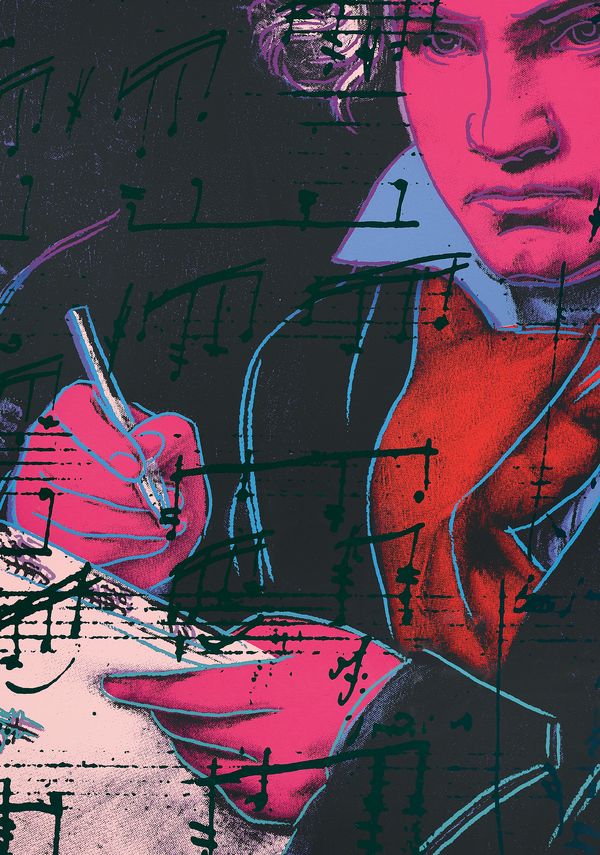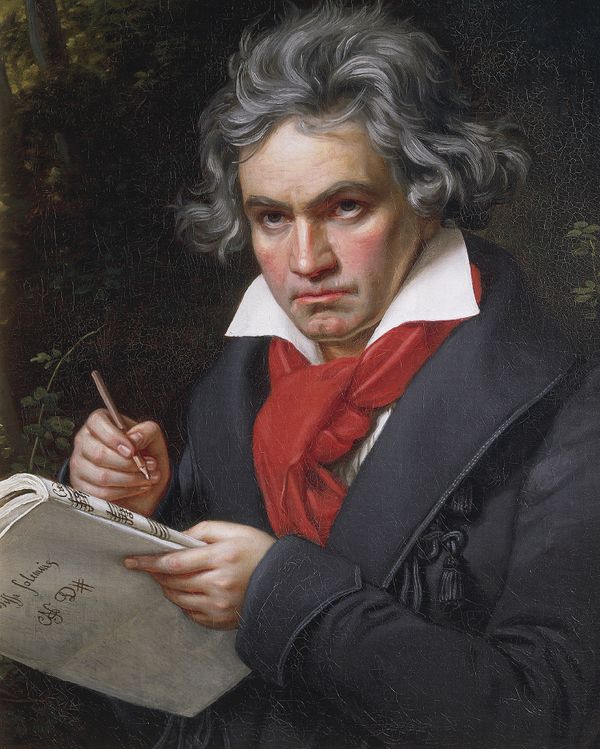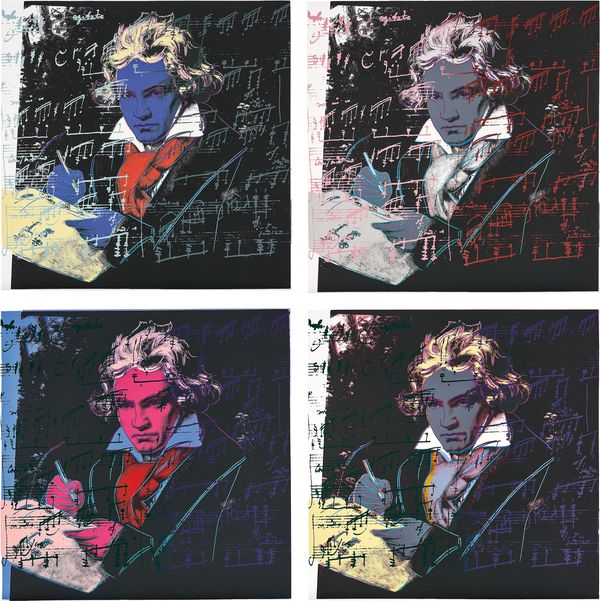Andy Warhol Beethoven, 1987 (detail)
A fascination with celebrity, posterity and the fabrication of icons was the driving force behind Andy Warhol’s portraiture, from his earliest screenprints of Elizabeth Taylor and Marilyn Monroe to the later representations of Vladimir Lenin. As a young child, Warhol obsessively collected autographed headshots of Hollywood stars—reverently compiling albums that documented the sometimes brief, sometimes enduring careers of the young, beautiful, and famous. His scrapbooks became a visual precursor to the serialised and repeated portraits that Warhol screenprinted of actresses, sports stars, politicians and historical figures.
Warhol’s goal was to create icons beyond mere representation, as he understood that in order to create an enduring image, he had to reduce and condense a person’s likeness to an instantly recognisable motif. His screenprinted portraits transcended the sitters’ biography and character, skirting the line of caricature to become more symbol than representation.
Joseph Karl Stieler Portrait of Ludwig van Beethoven (1770-1827), German composer and pianist, composing the Missa Solemnis, 1819-1820 © De Agostini Picture Library / A. Dagli Orti / Bridgeman Images
Created in 1987, shortly before his death, Warhol’s quartet of portraits of Ludwig van Beethoven (1770-1827) perfectly demonstrates the artist’s ability to manipulate and appropriate imagery to create a visual icon. For this set of screenprints, Andy Warhol took an already famous image of the German composer: an idealised and heroic portrait painted in 1820 by Joseph Karl Stieler (1781-1858), which has coloured our view of Beethoven’s personality and appearance unlike any other.
Long familiar through commercial overexposure, Stieler’s depiction of the composer’s leonine mane and impatient scowl are the visual tropes that Warhol emphasised through the use of colour. The alternate hot and cool tones of the composer’s face and cravat emerging from darkness heighten the intensity of Beethoven’s fixed gaze—keeping our attention closely on his visage, whilst simultaneously echoing the dramatic changes in volume and pace that Beethoven was so well-known for.Lot 39 Andy Warhol Beethoven, 1987 (detail)
Lot 39 Andy Warhol Beethoven, 1987 (detail)
However, Warhol pushes Stieler’s visual identifers of the composer one step further, beyond mere facial recognition. Not content with simply using the tools of Beethoven’s trade, the manuscript and pen, to allude to the composer’s talent, Warhol instead marches the music directly across the portrait itself. In Stieler’s painting, Beethoven holds the score for his late Missa solemnis (1819-1824). Finished three years before the composer’s death and often considered one of his greatest works, the Missa solemnis was nonetheless surpassed in popularity by the music that Warhol chose to identify the composer with: his Piano Sonata No. 14 in C# Minor, better (and more romantically) known as the Moonlight Sonata.
Lot 39 Andy Warhol Beethoven, 1987
Composed in 1801, the year that Beethoven first realised he was losing his hearing, the Moonlight Sonata took on a life beyond Beethoven’s intentions. Thought to have been inspired by the composer’s love for his 17-year old pupil, the Countess Giulietta Guicciardi (although more likely to have been composed as a funeral hymn) the Moonlight Sonata received its nickname from Berlin critic, Ludwig Rellstab, who in 1832 described the famous frst movement as like "a boat passing the wild scenery of Lake Lucerne in the moonlight". Although it wasn’t known by this evocative moniker until shortly after the composer’s death, the sonata was hugely popular from the moment it was written, exasperating Beethoven, who remarked to fellow composer, Carl Czerny, "Surely I’ve written better things."
In choosing the Moonlight Sonata to best identify Beethoven, Warhol reveals his insistent concern with representing not the true likeness, intentions or character of his sitters, but the condensed, most recognisable elements of their legend. In this quartet of portraits, Beethoven the man has been effaced to a certain extent, underneath the notes of his most famous composition, under the myth of his own celebrity.
Rebecca Tooby-Desmond is a Cataloguer for Modern & Contemporary Editions at Phillips in London.



